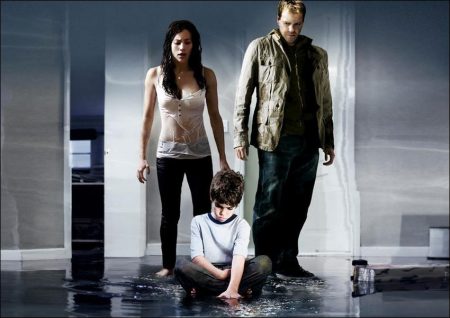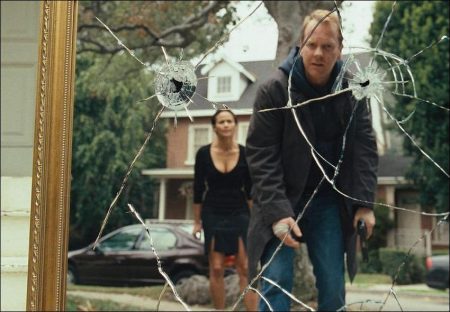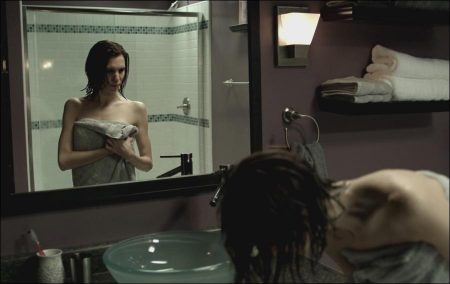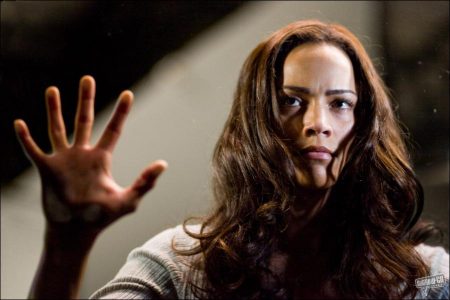Tagline: There is evil on the other side.
Mirrors movie storyline. In a bid to pull his shattered life back together, troubled ex-cop Ben Carson (Kiefer Sutherland) takes a job as a security guard at the burned out ruins of a once-prosperous department store. As Ben patrols the charred hallways, he begins to see horrifying images in the ornate mirrors that still adorn the walls. Ben soon realizes that a malevolent force is using the mirrors to gain entrance into this world, threatening the lives of his wife (Paula Patton) and children.
From the director of “The Hills Have Eyes” comes “Mirrors,” the terrifying story of troubled ex-cop who must save his family from an unspeakable evil that is using mirrors as a gateway into their home.
Ben Carson (Kiefer Sutherland) has seen better days. It’s been nearly a year since the volatile detective was suspended from the NYPD for fatally shooting another undercover officer, an accident that not only cost him his job, but fueled the alcoholism and anger that has alienated his wife and kids and left him crashing on his sister’s couch in Queens.
Desperate to pull his life together and reconnect with his family, Carson takes a job as a night watchman at the burned-out ruins of the Mayflower department store. What once was a symbol of prosperity and grandeur now sits decaying in the darkness like a rotting ghost ship, destroyed by a massive fire that devoured numerous innocent lives. As Carson patrols the eerie, charred remains of the store, he begins to notice something sinister about the ornate mirrors that adorn the Mayflower walls. Reflected in the gigantic shimmering glass are horrific images that stun Carson.
Beyond projecting gruesome images of the past, the mirrors appear to be manipulating reality as well. When Carson sees his own reflection being tortured, he suffers the physical effects of his fractured visions. Suddenly the troubled ex-cop finds himself battling his personal demons and the ones that have hijacked his reflection, tormenting him with convulsions, spontaneous bleeding and near suffocation.
His sympathetic but skeptical sister Angela (Amy Smart) dismisses these bizarre “nightmares” as a consequence of his stress and guilt over the accidental shooting, but Carson’s estranged wife Amy (Paula Patton), a no-nonsense NYPD medical examiner, is less forgiving. Her husband’s increasingly erratic behavior frightens her, pushing his family farther away – and, she fears, it’s putting their children in danger.
But a much deadlier threat looms, trapped within the mirrors and reflective surfaces that pervade their everyday life. As Carson investigates the mysterious disappearance of a Mayflower security guard and its possible connection to his ghastly visions, he realizes that a malevolent, otherworldly force is using reflections as a gateway to terrorize him and his family. If he has any hope of saving his wife and children from a horrifying death, Carson must somehow uncover the truth behind the mirrors – and convince Amy to help him battle the greatest evil he has ever faced.
A New Fear Unleashed: Behind the World of “Mirrors”
From folklore to fairy tales, superstition to religious tradition – the mythology surrounding mirrors has always tended toward the dark. The Romans imbued mirrors with the power to reflect one’s soul and affect his or her well-being. This, coupled with their belief that life renews itself every seven years, led to the centuries-old legend that seven years of bad luck will follow anyone who breaks a mirror.’ In film and literature, mirrors serve as symbols of vanity and dangerous portals of truth or transport to another time and place. The Jewish faith calls for all mirrors to be shrouded in one’s home while mourning the passing of a loved one, lest the living be distracted by the trappings of beauty and the physical world.
But these cautionary tales of narcissism and bad luck pale in comparison to the most common phenomenon associated with mirrors: death. Steeped in cultures from Rome to the Far East is a common lore casting mirrors as malevolent entities that trap the souls of the living – thereby causing death – or imprison the souls of the departed before they can reach the afterlife, cursing their spirits to eternal captivity. (It is also said that a vampire cannot cast a reflection, because it is a creature of the undead and has already lost its soul.) That the association between mirrors and death has endured through generations and permeated societies around the globe speaks not only to man’s complex relationship with the Great Unknown, but also with his reflection.
“Mirrors inherently challenge us to look inside ourselves,” observes Kiefer Sutherland. “It’s difficult to look at yourself. It doesn’t matter how good-looking you may be. On a physical level and a spiritual one as well, it’s hard to face yourself in a mirror. Depending on what you see, they can be very frightening.”
The darkest elements of this collective mythology are re-imagined for the 21st century in “Mirrors,” the terrifying story of a troubled ex-cop who must defend his family from a savage evil that uses reflective surfaces as gateways to terrorize them. In developing the film, a remake of the 2003 South Korean horror movie “Into the Mirror,” for New Regency, producer Alexandra Milchan saw the potential for a multi¬layered psychological thriller in the tradition of “The Shining.”
“Beyond the horror aspect of the original film, there is something very universal and interesting about the cultural mystique of mirrors that provided the basis for a great dramatic piece,” says Milchan, the producer of such films as “Goodbye Lover” and “Righteous Kill.”
She approached writer-director Alexandre Aja (“The Hills Have Eyes,” “High Tension”) about bringing his bold style and visceral storytelling to the project.
“I was looking for a project that would allow me to explore fear in a new way,” says Aja, who established himself as a potent new voice in the horror genre with the hit French slasher film “High Tension” and “The Hills Have Eyes,” his grisly remake of the 1977 thriller about a family’s struggle to survive a brutal massacre by mutant cannibals.
At the core of “Into the Mirror,” the story of a detective who investigates a series of gruesome murders revolving around mirrors, Aja found what he was looking for. “Everyone has relationship with their reflection,” he muses. “It’s something we don’t really think about, but it’s there. Some people love to look at themselves in the mirror; others hate it. Mirrors can show us the traumas and truths that exist in our subconscious, and are just waiting to be revealed.”
Having previously explored the sadistic extremes of human nature, Aja relished the opportunity to delve into the supernatural. “The concept was really original, and I wanted to create a story around it that would make audiences confront themselves and their fears in a way they’ve never imagined,” he says.
Together with Gregory Levasseur, his co-writer on “High Tension” and “The Hills Have Eyes,” Aja crafted a chilling new narrative for “Mirrors,” rooting the story in a man’s struggle for redemption that begins as a quest to reunite his estranged family, and quickly escalates into a ferocious battle for their lives.
“Everything is collapsing around him,” Aja says of Ben Carson, an NYPD detective who has been suspended for the fatal accidental shooting of another undercover officer. “He’s lost his job. He’s lost his family. He’s lost his soul.”
Consumed by guilt and anger, Carson has further alienated his wife and young children with his alcoholism and volatile temper. “He’s at the lowest point of his life,” Sutherland says of the troubled cop, who has been separated from his family for months, crashing on his sister’s couch and clinging to sobriety by a thread.
It was the film’s hybrid of well-crafted horror and genuine family drama that spoke to Sutherland. “Alex told me a beautiful story,” recalls the Emmy and Golden Globe-winning actor, who first met with Aja to discuss the project after wrapping a long night of shooting his hit FOX TV series “24.” “Horror is a genre that has always intrigued me, but what attracted me to this story is that it deals with a family that is desperately trying to figure out how to come back together. It’s about second chances. In this incredibly drastic situation, a man finds his true self and reconnects with his family. When things are at their worst, he becomes his best.”
Based on that brief meeting with Aja – and before even screening “The Hills Have Eyes” – Sutherland agreed to do the film. “I’m a gambler,” he says. “I like to play cards, I’ll bet on which dog will hit the corner first, and I had a real strong sense in that meeting with Alex that we were going to do something special together. I had faith and I feel very lucky that I was right.”
There may have been another reason why Sutherland committed to “Mirrors” without first having seen Aja’s celebrated remake of “Hills.” “Scary films are very hard for me to watch,” he admits. “I took my daughter to see ‘Finding Nemo’ and when the shark comes in the boat, my popcorn went in the air. My daughter was ten at the time and she laughed at me for it.”
“I knew Alex and Kiefer would get along unbelievably well, because they’re both very direct and intense,” Milchan observes. “If you look at the body of Kiefer’s work, he always gives 150 percent. He’s very focused and authentic, and audiences love that about him.”
Sutherland brings his trademark intensity to the role of Ben Carson, a man on the brink of losing everything that matters to him. Broke and desperate to rebuild his life, Carson takes a job as the night watchman at the Mayflower Department Store… or what’s left of it.
Looming against the night sky like a tattered ghost ship run aground in a thriving city, the Mayflower was once a symbol of luxury and grandeur, until a fire ravaged the store and claimed many innocent lives in the process. Five years have passed since the blaze, with the Mayflower mired in a morass of legal battles that has left it to decay in the darkness, suspended in time like an eerie snapshot of life tragically interrupted.
As he patrols the burned-out ruins of the store, Carson catches fleeting glimpses of distorted images reflected in the enormous, ornate mirrors that line its walls. What he thinks are merely bizarre hallucinations soon intensify as the mirrors reveal shocking and grotesque visions of profound suffering.
The images are so powerful and explicit – people burning alive, incinerating flesh melting to the bone – Carson feels their effects as if he were being consumed by fire himself.
But Aja and Levasseur’s screenplay takes the original concept way beyond mirrors. What if a malicious force trapped within our reflections – any reflection, anywhere – could use them as conduits to terrorize the living? “The idea that a whole other world can be living on a different plane, stuck watching our world in reverse, is a very scary idea,” says Sutherland.
The fear factor is amplified exponentially as ordinary reflective surfaces like windows, water, TV screens, stainless steel façades and picture frames are transformed into deadly channels of evil. Suddenly, Ben finds himself not only battling his own demons – but the ones that have hijacked his reflection.
“The reflections represent what we could be capable of,” Sutherland says of their thematic duality. “Good or bad, they reflect ourselves at various extremes. And they can make us do things that we wish we couldn’t.”
MIRRORS uses the power we give to our own self-image as a springboard to explore our subconscious fears. “You can jail yourself in your own idea of who you are, and see things in your reflection that others don’t see – things that don’t really exist,” observes Paula Patton (“Hitch,” “Déjà Vu”), who plays Ben’s estranged wife Amy. “Like an anorexic who sees a fat person in the mirror, when in fact their reflection shows a very skinny person looking back at them. It speaks to our brains’ ability to create whatever image we want to see, so that mirrors are never really an accurate reflection of ourselves.”
Milchan sees apt social commentary in Aja and Levasseur’s exploration of the myriad reflective surfaces that exist in everyday life. “If you look at the architecture of Dubai, New York or Las Vegas, it’s all about glass, mirrors, shiny surfaces,” she says. “The mirrors and reflective surfaces in the film represent our culture, and its emphasis on narcissism and money. ‘I’m here, I’m in your face. Watch me.'”
“If what you’re running from is your own self-image, it’s impossible to avoid it in our society,” Sutherland concludes. “There are too many reflective surfaces. Just try it. Walk two blocks and try not to see yourself in a reflection off a window, or in a puddle of water. It’s impossible to do. That creates a sense of paranoia for Ben, which was fantastic to play as an actor.”
In real life, Sutherland does not like mirrors. “I have one in my bathroom and I think I have one in my closet just to make sure I’ve got the right socks on, but outside of that, I don’t like looking at myself very much,” he says. “It’s very odd to be looking at yourself all the time while you’re working. That was a very interesting aspect of making this film.”
When Carson investigates the mysterious death of a Mayflower security guard and its potential connection to the store’s menacing mirrors, the evil that has targeted him expands its focus to his family – and their modest New Jersey home becomes a virtual playground for the possessed reflection of his son Michael. “A lot of what happens in the store, he thinks is coming from his imagination,” says Sutherland. “When people get that depressed and they feel that low, they question their own sanity. Ben does that to a point, but the second his family is threatened, he becomes very clear.”
Carson’s sister Angela, played by Amy Smart (“Starsky & Hutch”), dismisses his waking nightmares as a consequence of his guilt and stress over the accidental shooting. But his increasingly erratic behavior alarms his wife, a no-nonsense NYPD medical examiner.
“She thinks he’s gone off his rocker,” says Patton, who started reading the “Mirrors” script one evening…and had to wait until morning to finish it. (“That was a good sign,” she cracks.) “Amy is very logical, very left-brained and scientific-minded, so the idea of ghosts or otherworldly forces is not something she believes in. She has also seen a lot of gruesome and horrible things in her line of work, so she doesn’t scare easily.”
At the same time, she notices that something is “off” with their son Michael, who seems preoccupied with his reflection. “Their family is crumbling,” Patton says, “and Ben feels more alone than ever because no one believes him.”
“There is a great balance between their two storylines,” notes Aja. “At the beginning of the film, Amy is the strong one, keeping what’s left of their family together while Ben is at rock bottom. As Ben finds the strength to confront himself and the evil force that’s terrorizing them, he and Amy must fight on separate fronts for the same purpose – saving the kids, themselves, and most important, their family.”
Ultimately, Aja strived to make “Mirrors” as provocative as it is entertaining. “I hope this film has a huge psychological effect on the audience,” Aja says. “I want them to wonder, ‘Am I going to ever look in the mirror again, or will I be too scared?’ The next time they see their reflection, they may have a strange feeling that they’re not alone.”
Will Sutherland be able to watch “Mirrors”? “Hopefully, I’ll be smart enough not to take popcorn with me, but if I do, it’s gonna go in the air,” he jokes. “We’ve created something truly frightening that will stay with you, that will touch a fear inside you that is real, and we’ve blended it with this family drama that is so important to me – the story of a man who is looking for a second chance. By bringing these two genres together, I think we’ve given this film a depth that not many horror films have.”
Continue Reading and View the Theatrical Trailer
Mirrors (2008)
Directed by: Alexandre Aja
Starring: Amy Smart, Kiefer Sutherland, Paula Patton, Jason Flemyng, Julian Glover, Ezra Buzzington, John Shrapnel, Darren Kent, Ioana Abur, Erica Gluck, Cameron Boyce
Screenplay by: Alexandre Aja
Production Design by: Joseph C. Nemec
Cinematography by: Maxime Alexandre
Film Editing by: Baxter
Costume Design by: Michael Dennison, Ellen Mirojnick
Set Decoration by: Liz Griffiths, Ian Whittaker
Art Direction by: Stephen Bream, Vlad Roseanu
Music by: Javier Navarrete
MPAA Rating: R for strong violence, disturbing images, language and brief nudity
Studio: 20th Century Fox
Release Date: August 15, 2008
Views: 76






